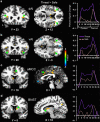Increased anterior insula activity in anxious individuals is linked to diminished perceived control
- PMID: 26125154
- PMCID: PMC4490294
- DOI: 10.1038/tp.2015.84
Increased anterior insula activity in anxious individuals is linked to diminished perceived control
Abstract
Individuals with high-trait anxiety frequently report decreased perceived control. However, it is unclear how these processes are instantiated at a neural level. Prior research suggests that individuals prone to anxiety may have exaggerated activity in the anterior insula and altered activity in the cingulate cortex during anticipation of aversive events. Thus, we hypothesized that anxiety proneness influences anterior insula activation during anticipation of unpredictable threat through decreased perceived control. Forty physically healthy adults underwent neuroimaging while they explored computer-simulated contexts associated either with or without the threat of an unpredictable shock. Skin conductance, anxiety ratings and blood oxygenation level-dependent (BOLD) functional magnetic resonance imaging were used to assess responses to threat versus no threat. Perceived control was measured using the Anxiety Control Questionnaire-Revised. Mediation analysis examined how anxiety proneness influenced BOLD activity. Anticipation of unpredictable threat resulted in increased skin conductance responses, anxiety ratings and enhanced activation in bilateral insula, anterior midcingulate cortex (aMCC) and bed nucleus of the stria terminalis. Individuals with greater anxiety proneness and less perceived control showed greater activity in dorsal anterior insula (dAI). Perceived control mediated the relationship between anxiety proneness and dAI activity. Increased dAI activity was associated with increased activity in aMCC, which correlated with increased exploratory behavior. Results provide evidence that exaggerated insula activation during the threat of unpredictable shock is directly related to low perceived control in anxiety-prone individuals. Perceived control thus may constitute an important treatment target to modulate insula activity during anxious anticipation in anxiety-disordered individuals.
Figures



References
-
- Spielberger CD.Theory and research on anxietyIn: Spielberger CD (ed). Anxiety and Behavior Academic Press: New York, USA; 19663–20.
-
- Rapee RM, Crake MG, Brown TA, Barlow DH. Measurement of per ceived control over anxiety-related events. Behav Ther. 1996;27:279–293.
-
- Barlow DH, Sauer-Zavala S, Carl JR, Bullis JR, Ellard KK. The nature, diagnosis, and treatment of neuroticism: back to the future. Clin Psychol Sci. 2013;2:344–365.
-
- Brown TA, White KS, Forsyth JP, Barlow DH. The structure of perceived emotional control: psychometric properties of a revised anxiety control questionnaire. Behav Ther. 2004;35:75–99.
-
- Gallagher MW, Bentley KH, Barlow DH. Perceived control and vulnerability to anxiety disorders: a meta-analytic review. Cogn Ther Res. 2014;38:571–584.
Publication types
MeSH terms
LinkOut - more resources
Full Text Sources
Other Literature Sources
Medical

